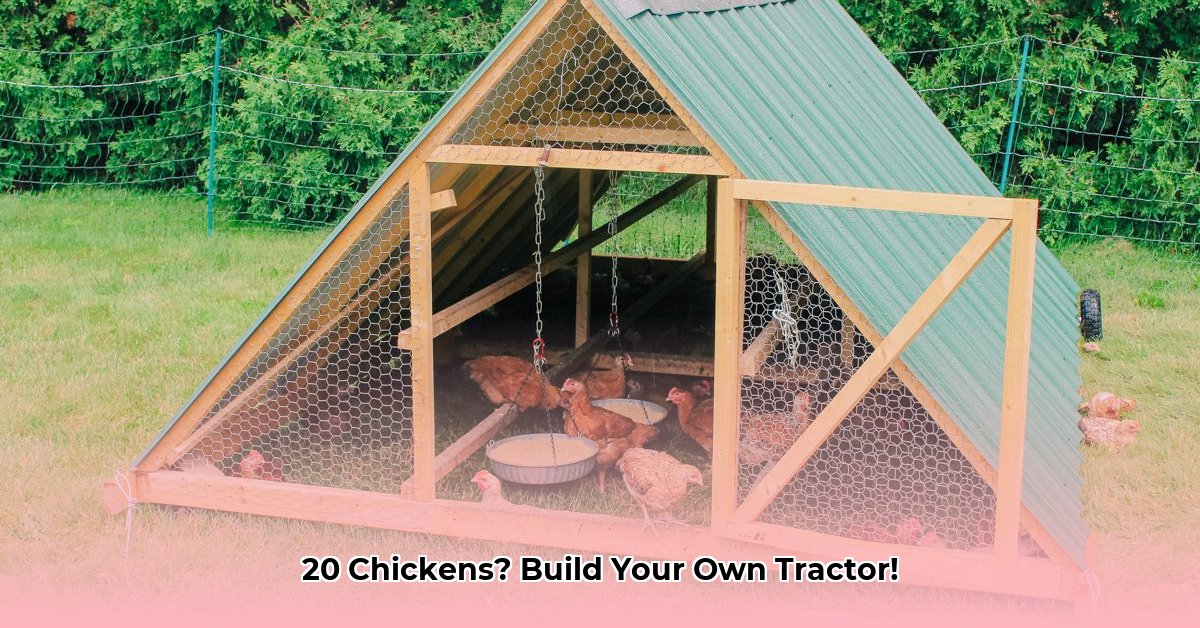
Building a chicken tractor for your flock offers a fantastic way to provide fresh pasture, enrich your soil, and manage your chickens sustainably. This comprehensive guide provides detailed instructions and design comparisons to build a chicken tractor perfect for 20 hens. Whether you're a seasoned homesteader or a beginner, we'll equip you with the knowledge and steps to success. For more chicken tractor ideas, check out this site.
Chicken Tractor Designs: A Comparative Analysis
Choosing the right design is crucial. Two popular options stand out: a simple tarp-covered model and a more robust Suscovich design with a metal roof. Let's weigh the pros and cons:
| Feature | Simple Tarp Model | Upgraded Suscovich (Metal Roof) |
|---|---|---|
| Initial Cost | Low | Moderate to High |
| Building Time | Quick and Easy | More Time-Consuming |
| Predator Protection | Low (Vulnerable to predators) | High (Superior security) |
| Weather Resistance | Low (Susceptible to damage) | High (Excellent protection) |
| Durability | Low (Frequent repairs needed) | High (Built to last) |
| Materials Needed | Wood, wire mesh, tarp, basic hardware | Wood, wire mesh, metal roofing sheets, more hardware |
| Ongoing Maintenance | More frequent (Regular tarp checks) | Less frequent (Mostly structural checks) |
Which design is right for you? The simple tarp model offers a low-cost entry point, perfect for testing the waters or short-term needs. However, the upgraded Suscovich design, with its superior protection and longer lifespan, represents a more significant investment that pays off in the long run. Consider your budget, time commitment, and local predator pressure when making your choice.
Building Your Chicken Tractor: A Step-by-Step Guide (Upgraded Suscovich Design)
The Suscovich model, enhanced with a metal roof, provides exceptional protection and is highly recommended for a long-term solution.
Step 1: Gather Your Supplies. This crucial preparatory step prevents delays later. You'll need:
- Pressure-treated lumber (for a durable frame)
- Heavy-duty wire mesh (to keep chickens in and predators out)
- Metal roofing sheets (weather-resistant and durable)
- Strong hinges (for secure doors)
- Wheels or runners (for easy mobility)
- Fasteners (screws, nails – galvanized or stainless steel recommended)
- Tools (hammer, saw, measuring tape, drill, etc.)
Step 2: Construct the Frame. Build a sturdy rectangular frame, ensuring enough space for your 20 hens to comfortably roam, roost, and lay eggs. Follow local building codes and regulations.
Step 3: Install Wire Mesh. Securely attach the wire mesh to the frame, leaving no gaps. Overlap the mesh and use strong fasteners for optimal security.
Step 4: Secure the Metal Roof. Carefully attach the metal roofing sheets, ensuring a waterproof and secure fit. Overlap sheets correctly for both waterproofing and strength.
Step 5: Add Wheels or Runners. Attach your chosen mobility system, making moving the tractor effortless. Choose durable wheels capable of handling the tractor's weight.
Step 6: Incorporate Access Points. Build secure doors for feeding, watering, and cleaning. Easy access is critical for efficient management.
Step 7: Ensure Proper Ventilation. Adequate ventilation prevents heat buildup and moisture problems. Consider adding small vents for optimal airflow.
Troubleshooting and Maintenance
- Regular Inspection: Inspect for damages, addressing small issues before they escalate.
- Pasture Rotation: Rotate your chickens' pasture to maintain soil health and prevent overgrazing.
- Predator Control: Address any predator damage promptly to prevent further issues.
- Nesting Box: Add a nesting box for your hens' comfort.
- Cleaning: Regular cleaning is paramount for a healthy flock environment. Adjust your cleaning schedule according to the seasons.
Long-Term Considerations: Maximizing Your Chicken Tractor's Life
A well-maintained chicken tractor is a valuable asset. Regular maintenance, which includes cleaning and seasonal adjustments, significantly extends its life. Remember: A thriving flock contributes to a healthy and sustainable backyard ecosystem.
Predator Protection Strategies Beyond Roof Design
Remember that a well-built roof only addresses part of predator protection. Consider adding these layers of defense:
- Hardware cloth: Secure the base to prevent digging predators.
- Electric netting: Deters predators with a shock.
- Livestock Guardian Dogs (LGDs): A powerful, but responsible, solution. Check local regulations.
By following these steps and implementing these additional safety measures, you’ll construct a secure and durable chicken tractor that provides years of healthy eggs and happy chickens. Remember to prioritize your flock's safety and well-being throughout the process.